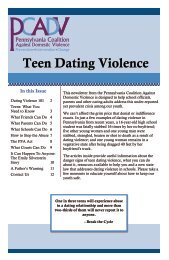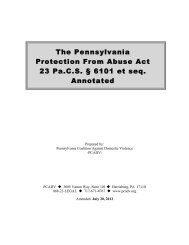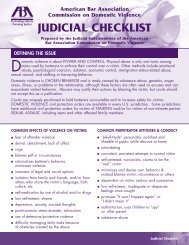Toolkit with Report Form - Pennsylvania Coalition Against Domestic ...
Toolkit with Report Form - Pennsylvania Coalition Against Domestic ...
Toolkit with Report Form - Pennsylvania Coalition Against Domestic ...
Create successful ePaper yourself
Turn your PDF publications into a flip-book with our unique Google optimized e-Paper software.
Section four<br />
RESPONDING TO A subpoena<br />
A subpoena is a document from the court used to compel an individual to<br />
testify or provide documents about a civil or criminal case. If a person who is<br />
subpoenaed fails to appear, a warrant may be issued for their arrest.<br />
Subpoena For Shelter Residents:<br />
◗ Program staff should never accept a<br />
subpoena directed to a resident.<br />
• The response should be: “I have no<br />
information for you” or “I can neither<br />
confirm nor deny that the person is here.”<br />
• The consequences for accepting a<br />
subpoena on behalf of a shelter resident<br />
are great. For instance, accepting a<br />
subpoena for a shelter resident breaches<br />
that resident’s legally protected,<br />
confidential information and may open<br />
the program to legal liability.<br />
◗ The program should inform the resident<br />
about the subpoena and suggest the resident<br />
consult an attorney. The program must never<br />
advise the resident to flee or destroy evidence<br />
that the subpoena requests.<br />
Subpoena For Program or Staff:<br />
◗ Do not accept service of the subpoena:<br />
politely inform the person delivering the<br />
subpoena that the executive director is the<br />
only person who can accept a subpoena.<br />
◗ Contact the executive director and<br />
program attorney immediately.<br />
◗ Keep detailed notes about how the<br />
subpoena was served.<br />
◗ The executive director, together <strong>with</strong> the<br />
program attorney, should assess the nature<br />
of the request and decide whether to comply<br />
<strong>with</strong> or resist the subpoena.<br />
• It is a best practice to always resist<br />
a subpoena unless and until a resident<br />
asks the program to disclose and signs a<br />
written release.<br />
• Even if the resident consents to disclosure,<br />
the program may oppose the subpoena to<br />
protect other confidential information.<br />
Resisting a Subpoena?<br />
◗ The executive director and program<br />
attorney should identify the source of the<br />
subpoena and ask the issuing attorney to<br />
<strong>with</strong>draw it based on the absolute privilege<br />
extended to confidential communications<br />
between programs and service recipients.<br />
◗ If the issuing attorney will not <strong>with</strong>draw the<br />
subpoena, file a Motion to Quash as soon as<br />
possible.<br />
• Along <strong>with</strong> filing a Motion to Quash,<br />
the program attorney should request a<br />
hearing and attach a memorandum of law<br />
that lays out legal arguments in support of<br />
quashing the subpoena. This will help to<br />
build a record in case of appeal.<br />
• PCADV’s Legal Department can provide<br />
a sample motion and/or memorandum of<br />
law and can assist the program attorney,<br />
if needed.<br />
◗ If the Motion to Quash is denied, a<br />
Motion for Protective Order should be filed<br />
immediately to limit the information that must<br />
be disclosed.<br />
• A Protective Order protects certain<br />
portions of a record, such as the shelter’s<br />
address or the identity of other clients or<br />
program staff.<br />
• A Protective Order may limit physical<br />
access to records or the nature of compelled<br />
testimony, such as how testimony is given<br />
and who may be present.<br />
page 12<br />
When Crisis Strikes | <strong>Pennsylvania</strong> <strong>Coalition</strong> <strong>Against</strong> <strong>Domestic</strong> Violence | 2012








